Tactical Group: Risk Management and Sustainability Analysis Report
VerifiedAdded on 2022/09/05
|8
|2793
|21
Report
AI Summary
This report provides a comprehensive analysis of Tactical Group's risk assessment and sustainability practices. Part A focuses on risk management, detailing identified risks, their levels, and the managerial approaches employed, including avoidance, reduction, sharing, and retention strategies. Part B delves into the company's sustainability report, examining economic, environmental, and social aspects based on GRI standards. The economic section covers financial assistance, infrastructure investments, and local supplier spending. The environmental section addresses material usage, recycling, and significant spills. The social section explores child labor issues, employee training on human rights, and marketing communication compliance. The report highlights both negative impacts, such as environmental spills and non-compliance, and the company's efforts to address and resolve these issues, demonstrating its commitment to sustainability and responsible business practices. Tactical Group has shown commitment to the GRI standards and has highlighted areas for improvement.
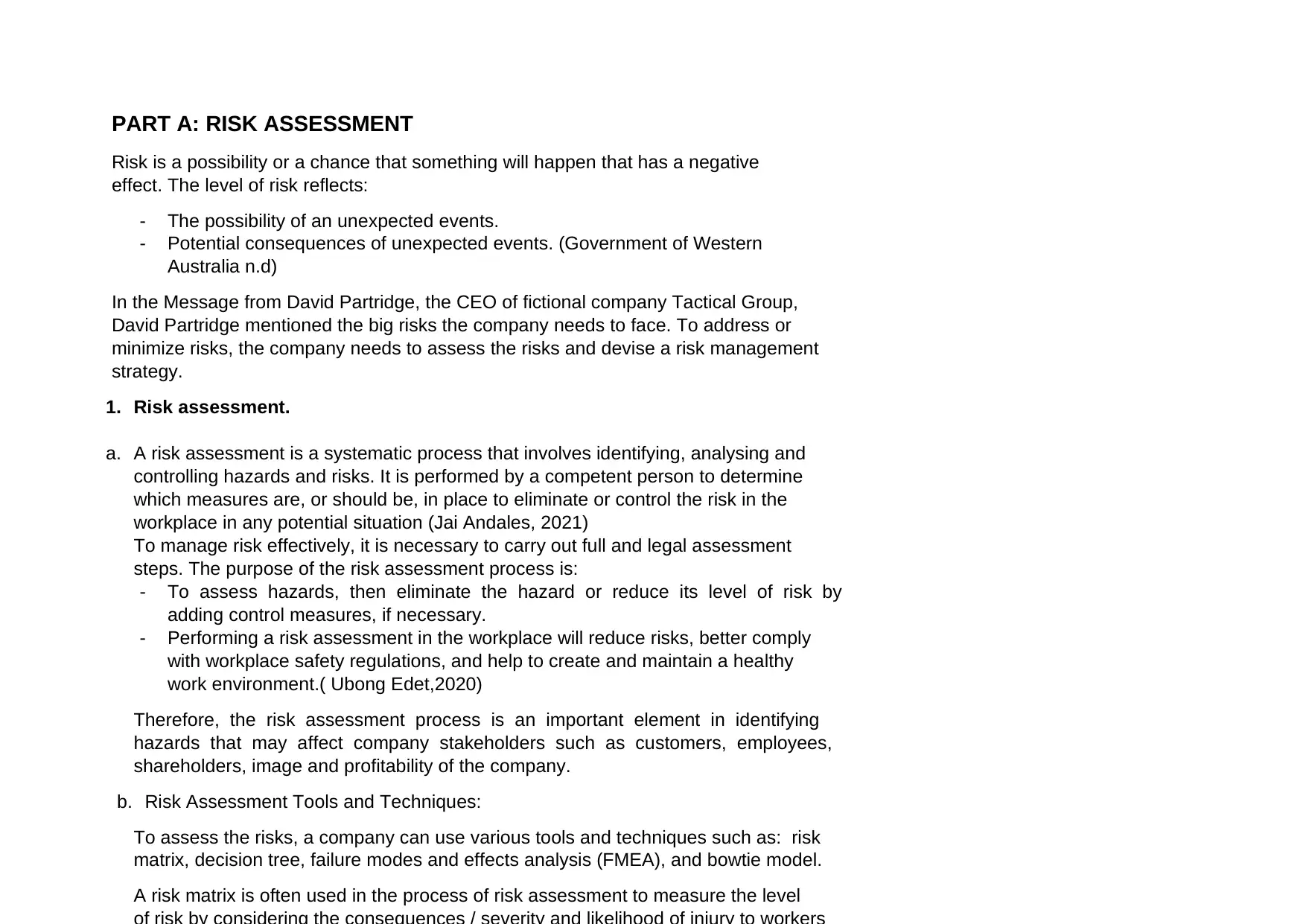
PART A: RISK ASSESSMENT
Risk is a possibility or a chance that something will happen that has a negative
effect. The level of risk reflects:
- The possibility of an unexpected events.
- Potential consequences of unexpected events. (Government of Western
Australia n.d)
In the Message from David Partridge, the CEO of fictional company Tactical Group,
David Partridge mentioned the big risks the company needs to face. To address or
minimize risks, the company needs to assess the risks and devise a risk management
strategy.
1. Risk assessment.
a. A risk assessment is a systematic process that involves identifying, analysing and
controlling hazards and risks. It is performed by a competent person to determine
which measures are, or should be, in place to eliminate or control the risk in the
workplace in any potential situation (Jai Andales, 2021)
To manage risk effectively, it is necessary to carry out full and legal assessment
steps. The purpose of the risk assessment process is:
- To assess hazards, then eliminate the hazard or reduce its level of risk by
adding control measures, if necessary.
- Performing a risk assessment in the workplace will reduce risks, better comply
with workplace safety regulations, and help to create and maintain a healthy
work environment.( Ubong Edet,2020)
Therefore, the risk assessment process is an important element in identifying
hazards that may affect company stakeholders such as customers, employees,
shareholders, image and profitability of the company.
b. Risk Assessment Tools and Techniques:
To assess the risks, a company can use various tools and techniques such as: risk
matrix, decision tree, failure modes and effects analysis (FMEA), and bowtie model.
A risk matrix is often used in the process of risk assessment to measure the level
Risk is a possibility or a chance that something will happen that has a negative
effect. The level of risk reflects:
- The possibility of an unexpected events.
- Potential consequences of unexpected events. (Government of Western
Australia n.d)
In the Message from David Partridge, the CEO of fictional company Tactical Group,
David Partridge mentioned the big risks the company needs to face. To address or
minimize risks, the company needs to assess the risks and devise a risk management
strategy.
1. Risk assessment.
a. A risk assessment is a systematic process that involves identifying, analysing and
controlling hazards and risks. It is performed by a competent person to determine
which measures are, or should be, in place to eliminate or control the risk in the
workplace in any potential situation (Jai Andales, 2021)
To manage risk effectively, it is necessary to carry out full and legal assessment
steps. The purpose of the risk assessment process is:
- To assess hazards, then eliminate the hazard or reduce its level of risk by
adding control measures, if necessary.
- Performing a risk assessment in the workplace will reduce risks, better comply
with workplace safety regulations, and help to create and maintain a healthy
work environment.( Ubong Edet,2020)
Therefore, the risk assessment process is an important element in identifying
hazards that may affect company stakeholders such as customers, employees,
shareholders, image and profitability of the company.
b. Risk Assessment Tools and Techniques:
To assess the risks, a company can use various tools and techniques such as: risk
matrix, decision tree, failure modes and effects analysis (FMEA), and bowtie model.
A risk matrix is often used in the process of risk assessment to measure the level
Paraphrase This Document
Need a fresh take? Get an instant paraphrase of this document with our AI Paraphraser
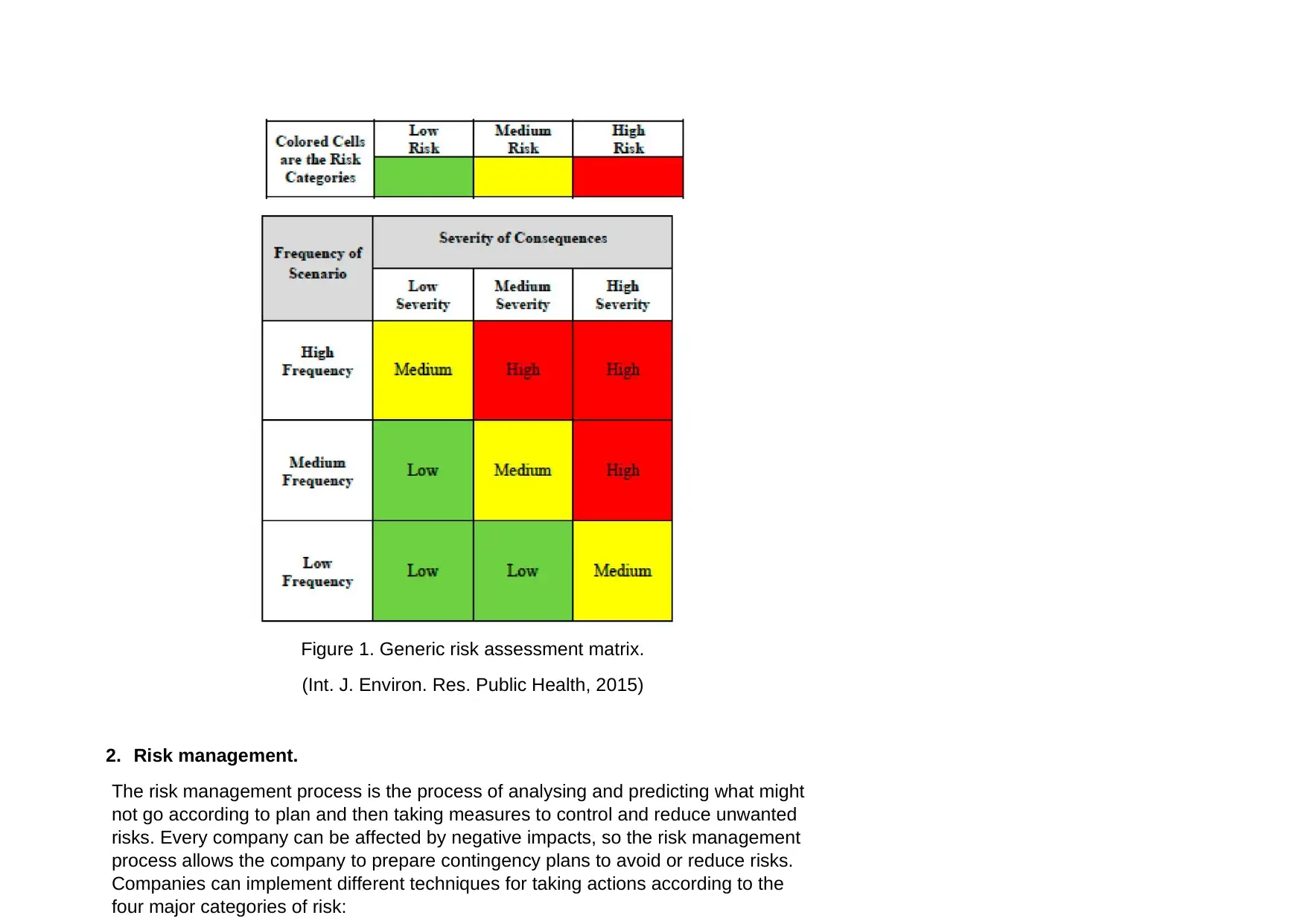
Figure 1. Generic risk assessment matrix.
(Int. J. Environ. Res. Public Health, 2015)
2. Risk management.
The risk management process is the process of analysing and predicting what might
not go according to plan and then taking measures to control and reduce unwanted
risks. Every company can be affected by negative impacts, so the risk management
process allows the company to prepare contingency plans to avoid or reduce risks.
Companies can implement different techniques for taking actions according to the
four major categories of risk:
(Int. J. Environ. Res. Public Health, 2015)
2. Risk management.
The risk management process is the process of analysing and predicting what might
not go according to plan and then taking measures to control and reduce unwanted
risks. Every company can be affected by negative impacts, so the risk management
process allows the company to prepare contingency plans to avoid or reduce risks.
Companies can implement different techniques for taking actions according to the
four major categories of risk:
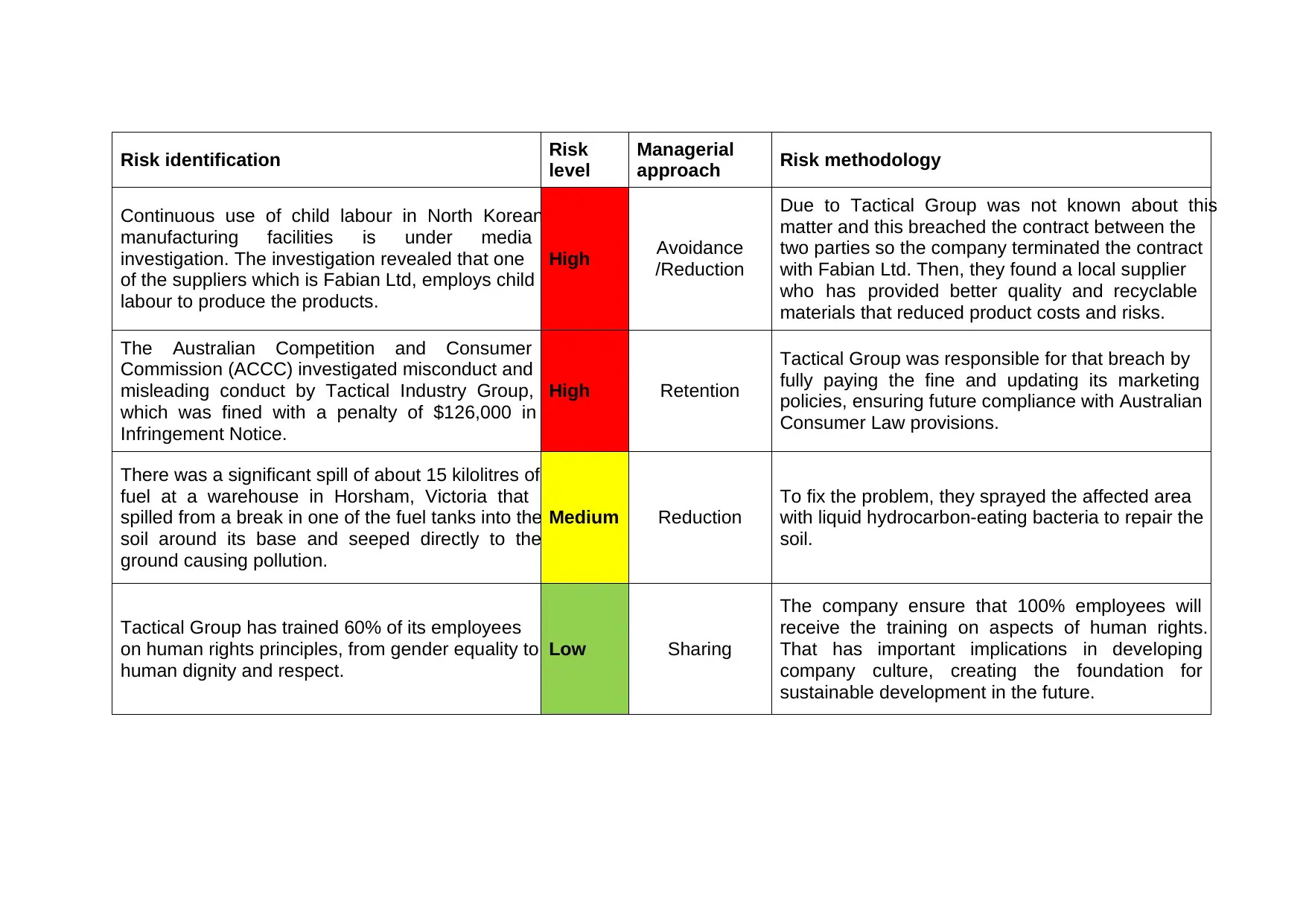
Risk identification Risk
level
Managerial
approach Risk methodology
Continuous use of child labour in North Korean
manufacturing facilities is under media
investigation. The investigation revealed that one
of the suppliers which is Fabian Ltd, employs child
labour to produce the products.
High Avoidance
/Reduction
Due to Tactical Group was not known about this
matter and this breached the contract between the
two parties so the company terminated the contract
with Fabian Ltd. Then, they found a local supplier
who has provided better quality and recyclable
materials that reduced product costs and risks.
The Australian Competition and Consumer
Commission (ACCC) investigated misconduct and
misleading conduct by Tactical Industry Group,
which was fined with a penalty of $126,000 in
Infringement Notice.
High Retention
Tactical Group was responsible for that breach by
fully paying the fine and updating its marketing
policies, ensuring future compliance with Australian
Consumer Law provisions.
There was a significant spill of about 15 kilolitres of
fuel at a warehouse in Horsham, Victoria that
spilled from a break in one of the fuel tanks into the
soil around its base and seeped directly to the
ground causing pollution.
Medium Reduction
To fix the problem, they sprayed the affected area
with liquid hydrocarbon-eating bacteria to repair the
soil.
Tactical Group has trained 60% of its employees
on human rights principles, from gender equality to
human dignity and respect.
Low Sharing
The company ensure that 100% employees will
receive the training on aspects of human rights.
That has important implications in developing
company culture, creating the foundation for
sustainable development in the future.
level
Managerial
approach Risk methodology
Continuous use of child labour in North Korean
manufacturing facilities is under media
investigation. The investigation revealed that one
of the suppliers which is Fabian Ltd, employs child
labour to produce the products.
High Avoidance
/Reduction
Due to Tactical Group was not known about this
matter and this breached the contract between the
two parties so the company terminated the contract
with Fabian Ltd. Then, they found a local supplier
who has provided better quality and recyclable
materials that reduced product costs and risks.
The Australian Competition and Consumer
Commission (ACCC) investigated misconduct and
misleading conduct by Tactical Industry Group,
which was fined with a penalty of $126,000 in
Infringement Notice.
High Retention
Tactical Group was responsible for that breach by
fully paying the fine and updating its marketing
policies, ensuring future compliance with Australian
Consumer Law provisions.
There was a significant spill of about 15 kilolitres of
fuel at a warehouse in Horsham, Victoria that
spilled from a break in one of the fuel tanks into the
soil around its base and seeped directly to the
ground causing pollution.
Medium Reduction
To fix the problem, they sprayed the affected area
with liquid hydrocarbon-eating bacteria to repair the
soil.
Tactical Group has trained 60% of its employees
on human rights principles, from gender equality to
human dignity and respect.
Low Sharing
The company ensure that 100% employees will
receive the training on aspects of human rights.
That has important implications in developing
company culture, creating the foundation for
sustainable development in the future.
⊘ This is a preview!⊘
Do you want full access?
Subscribe today to unlock all pages.

Trusted by 1+ million students worldwide
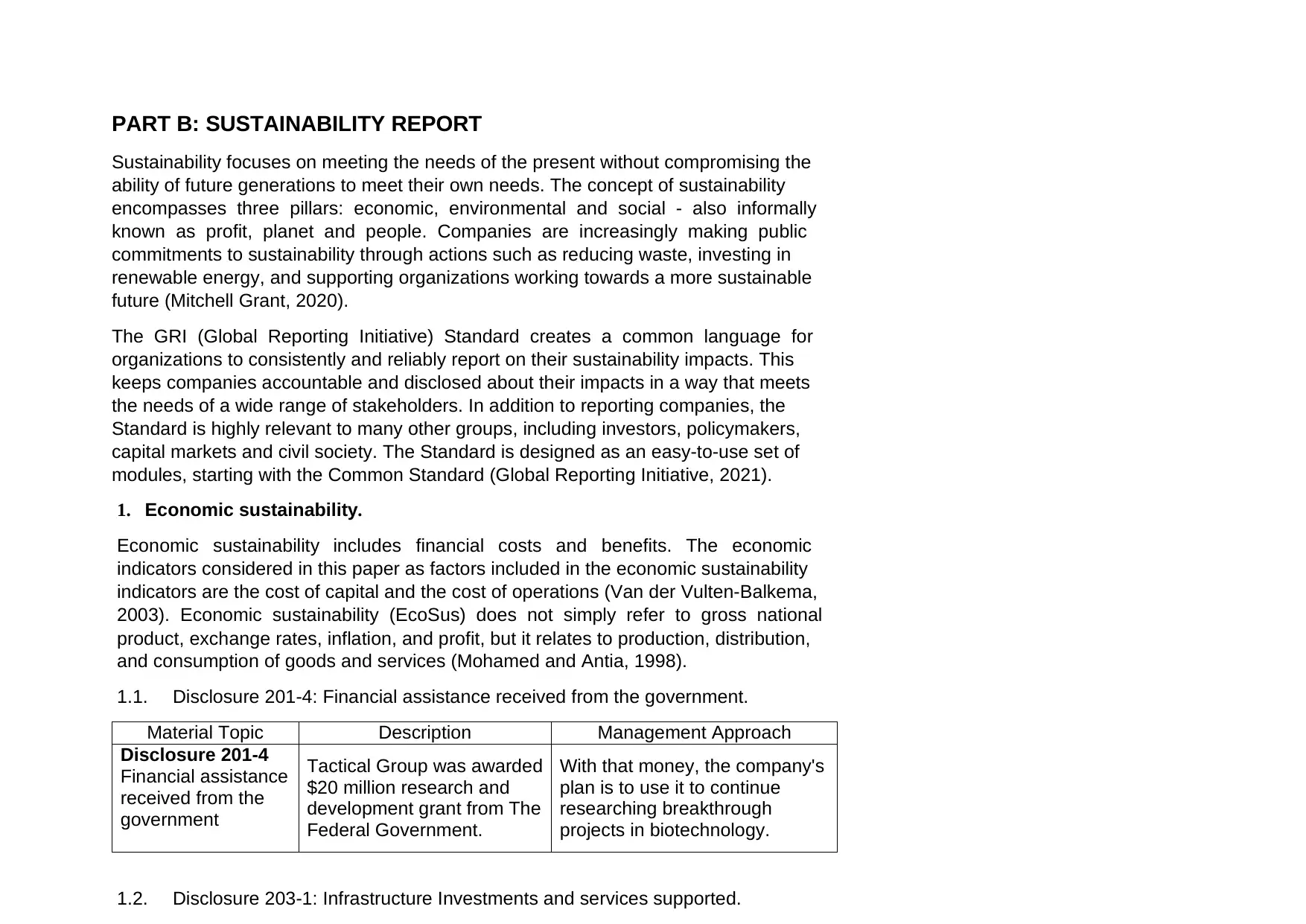
PART B: SUSTAINABILITY REPORT
Sustainability focuses on meeting the needs of the present without compromising the
ability of future generations to meet their own needs. The concept of sustainability
encompasses three pillars: economic, environmental and social - also informally
known as profit, planet and people. Companies are increasingly making public
commitments to sustainability through actions such as reducing waste, investing in
renewable energy, and supporting organizations working towards a more sustainable
future (Mitchell Grant, 2020).
The GRI (Global Reporting Initiative) Standard creates a common language for
organizations to consistently and reliably report on their sustainability impacts. This
keeps companies accountable and disclosed about their impacts in a way that meets
the needs of a wide range of stakeholders. In addition to reporting companies, the
Standard is highly relevant to many other groups, including investors, policymakers,
capital markets and civil society. The Standard is designed as an easy-to-use set of
modules, starting with the Common Standard (Global Reporting Initiative, 2021).
1. Economic sustainability.
Economic sustainability includes financial costs and benefits. The economic
indicators considered in this paper as factors included in the economic sustainability
indicators are the cost of capital and the cost of operations (Van der Vulten-Balkema,
2003). Economic sustainability (EcoSus) does not simply refer to gross national
product, exchange rates, inflation, and profit, but it relates to production, distribution,
and consumption of goods and services (Mohamed and Antia, 1998).
1.1. Disclosure 201-4: Financial assistance received from the government.
Material Topic Description Management Approach
Disclosure 201-4
Financial assistance
received from the
government
Tactical Group was awarded
$20 million research and
development grant from The
Federal Government.
With that money, the company's
plan is to use it to continue
researching breakthrough
projects in biotechnology.
1.2. Disclosure 203-1: Infrastructure Investments and services supported.
Sustainability focuses on meeting the needs of the present without compromising the
ability of future generations to meet their own needs. The concept of sustainability
encompasses three pillars: economic, environmental and social - also informally
known as profit, planet and people. Companies are increasingly making public
commitments to sustainability through actions such as reducing waste, investing in
renewable energy, and supporting organizations working towards a more sustainable
future (Mitchell Grant, 2020).
The GRI (Global Reporting Initiative) Standard creates a common language for
organizations to consistently and reliably report on their sustainability impacts. This
keeps companies accountable and disclosed about their impacts in a way that meets
the needs of a wide range of stakeholders. In addition to reporting companies, the
Standard is highly relevant to many other groups, including investors, policymakers,
capital markets and civil society. The Standard is designed as an easy-to-use set of
modules, starting with the Common Standard (Global Reporting Initiative, 2021).
1. Economic sustainability.
Economic sustainability includes financial costs and benefits. The economic
indicators considered in this paper as factors included in the economic sustainability
indicators are the cost of capital and the cost of operations (Van der Vulten-Balkema,
2003). Economic sustainability (EcoSus) does not simply refer to gross national
product, exchange rates, inflation, and profit, but it relates to production, distribution,
and consumption of goods and services (Mohamed and Antia, 1998).
1.1. Disclosure 201-4: Financial assistance received from the government.
Material Topic Description Management Approach
Disclosure 201-4
Financial assistance
received from the
government
Tactical Group was awarded
$20 million research and
development grant from The
Federal Government.
With that money, the company's
plan is to use it to continue
researching breakthrough
projects in biotechnology.
1.2. Disclosure 203-1: Infrastructure Investments and services supported.
Paraphrase This Document
Need a fresh take? Get an instant paraphrase of this document with our AI Paraphraser
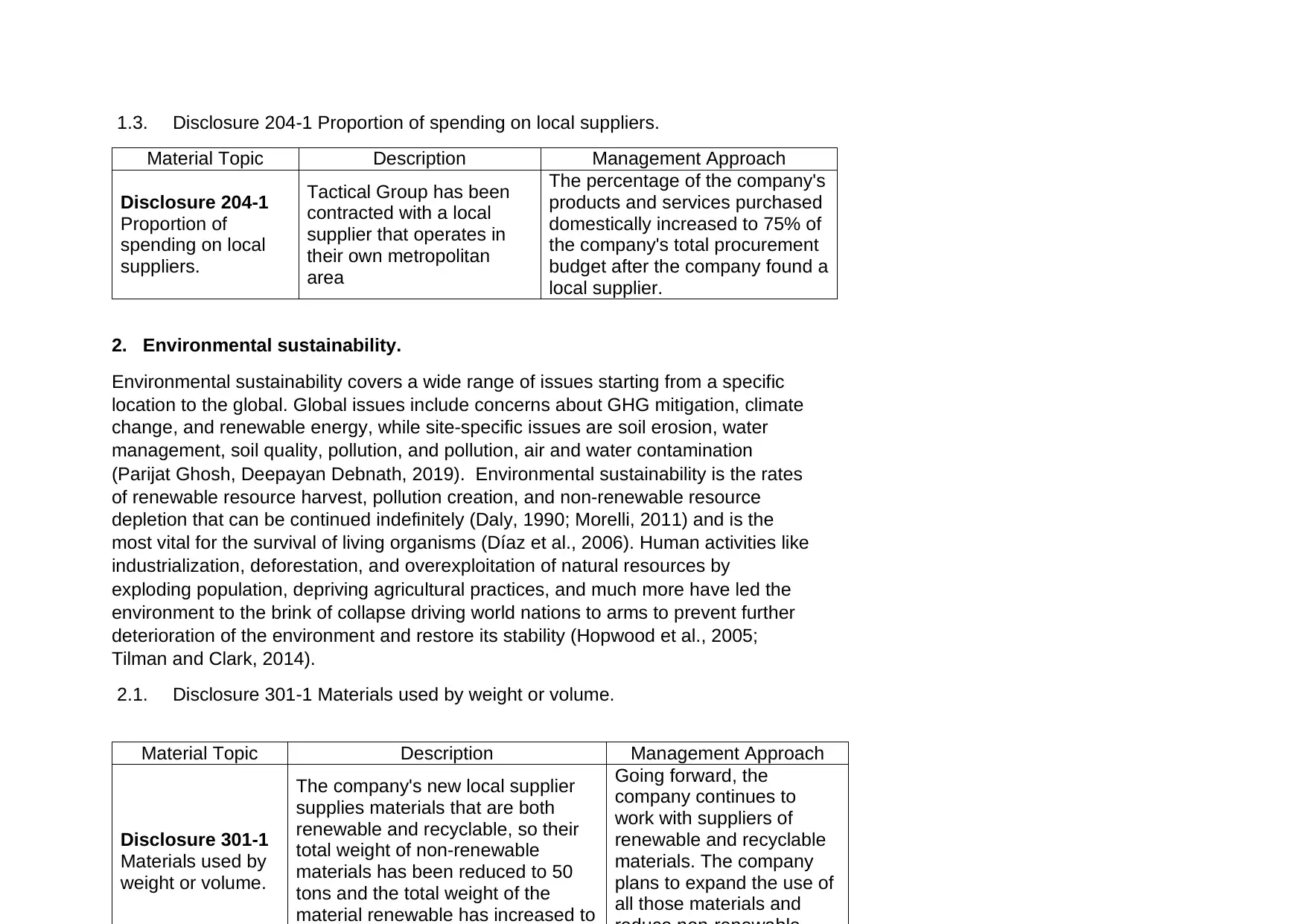
1.3. Disclosure 204-1 Proportion of spending on local suppliers.
Material Topic Description Management Approach
Disclosure 204-1
Proportion of
spending on local
suppliers.
Tactical Group has been
contracted with a local
supplier that operates in
their own metropolitan
area
The percentage of the company's
products and services purchased
domestically increased to 75% of
the company's total procurement
budget after the company found a
local supplier.
2. Environmental sustainability.
Environmental sustainability covers a wide range of issues starting from a specific
location to the global. Global issues include concerns about GHG mitigation, climate
change, and renewable energy, while site-specific issues are soil erosion, water
management, soil quality, pollution, and pollution, air and water contamination
(Parijat Ghosh, Deepayan Debnath, 2019). Environmental sustainability is the rates
of renewable resource harvest, pollution creation, and non-renewable resource
depletion that can be continued indefinitely (Daly, 1990; Morelli, 2011) and is the
most vital for the survival of living organisms (Díaz et al., 2006). Human activities like
industrialization, deforestation, and overexploitation of natural resources by
exploding population, depriving agricultural practices, and much more have led the
environment to the brink of collapse driving world nations to arms to prevent further
deterioration of the environment and restore its stability (Hopwood et al., 2005;
Tilman and Clark, 2014).
2.1. Disclosure 301-1 Materials used by weight or volume.
Material Topic Description Management Approach
Disclosure 301-1
Materials used by
weight or volume.
The company's new local supplier
supplies materials that are both
renewable and recyclable, so their
total weight of non-renewable
materials has been reduced to 50
tons and the total weight of the
material renewable has increased to
Going forward, the
company continues to
work with suppliers of
renewable and recyclable
materials. The company
plans to expand the use of
all those materials and
Material Topic Description Management Approach
Disclosure 204-1
Proportion of
spending on local
suppliers.
Tactical Group has been
contracted with a local
supplier that operates in
their own metropolitan
area
The percentage of the company's
products and services purchased
domestically increased to 75% of
the company's total procurement
budget after the company found a
local supplier.
2. Environmental sustainability.
Environmental sustainability covers a wide range of issues starting from a specific
location to the global. Global issues include concerns about GHG mitigation, climate
change, and renewable energy, while site-specific issues are soil erosion, water
management, soil quality, pollution, and pollution, air and water contamination
(Parijat Ghosh, Deepayan Debnath, 2019). Environmental sustainability is the rates
of renewable resource harvest, pollution creation, and non-renewable resource
depletion that can be continued indefinitely (Daly, 1990; Morelli, 2011) and is the
most vital for the survival of living organisms (Díaz et al., 2006). Human activities like
industrialization, deforestation, and overexploitation of natural resources by
exploding population, depriving agricultural practices, and much more have led the
environment to the brink of collapse driving world nations to arms to prevent further
deterioration of the environment and restore its stability (Hopwood et al., 2005;
Tilman and Clark, 2014).
2.1. Disclosure 301-1 Materials used by weight or volume.
Material Topic Description Management Approach
Disclosure 301-1
Materials used by
weight or volume.
The company's new local supplier
supplies materials that are both
renewable and recyclable, so their
total weight of non-renewable
materials has been reduced to 50
tons and the total weight of the
material renewable has increased to
Going forward, the
company continues to
work with suppliers of
renewable and recyclable
materials. The company
plans to expand the use of
all those materials and
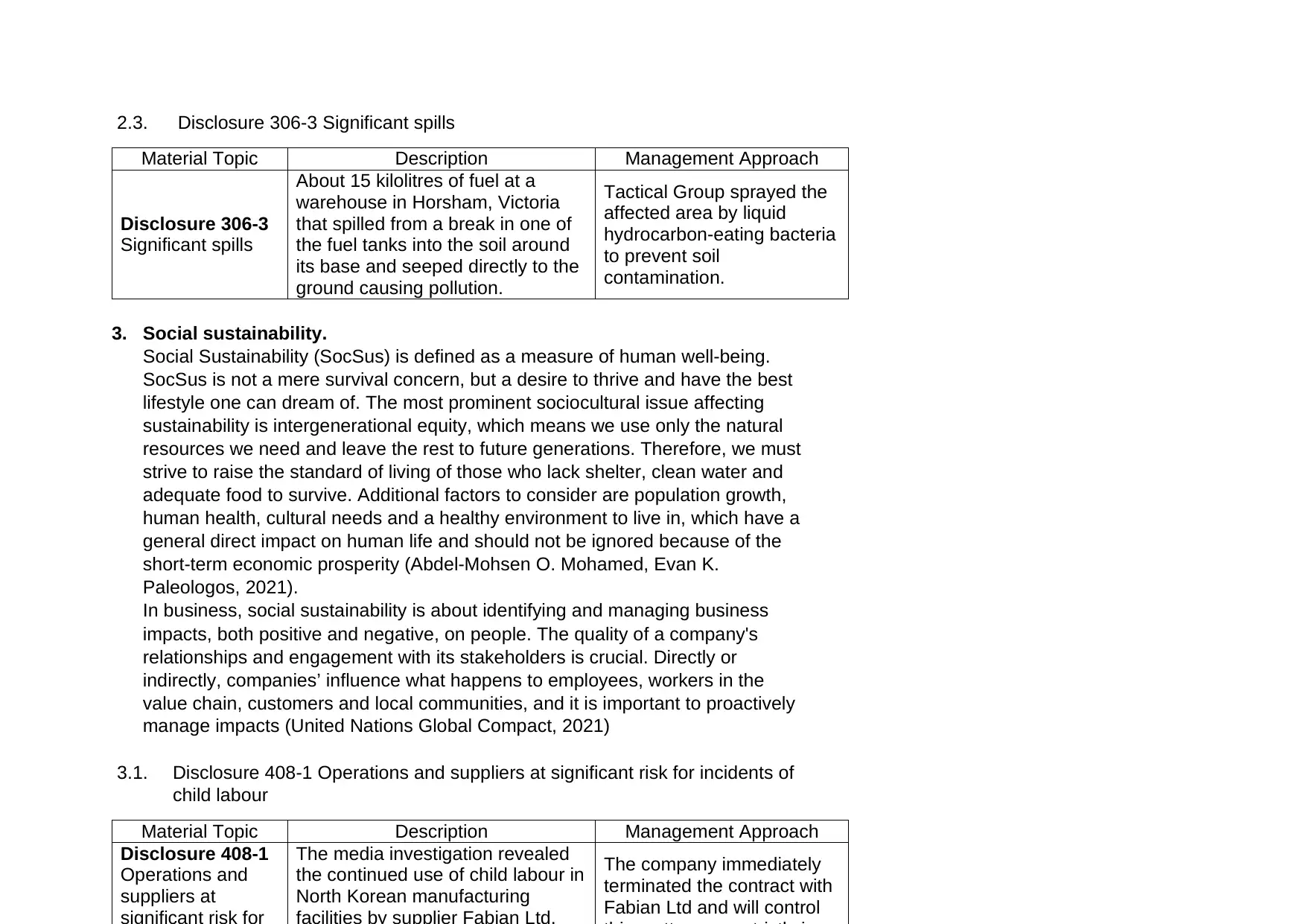
2.3. Disclosure 306-3 Significant spills
Material Topic Description Management Approach
Disclosure 306-3
Significant spills
About 15 kilolitres of fuel at a
warehouse in Horsham, Victoria
that spilled from a break in one of
the fuel tanks into the soil around
its base and seeped directly to the
ground causing pollution.
Tactical Group sprayed the
affected area by liquid
hydrocarbon-eating bacteria
to prevent soil
contamination.
3. Social sustainability.
Social Sustainability (SocSus) is defined as a measure of human well-being.
SocSus is not a mere survival concern, but a desire to thrive and have the best
lifestyle one can dream of. The most prominent sociocultural issue affecting
sustainability is intergenerational equity, which means we use only the natural
resources we need and leave the rest to future generations. Therefore, we must
strive to raise the standard of living of those who lack shelter, clean water and
adequate food to survive. Additional factors to consider are population growth,
human health, cultural needs and a healthy environment to live in, which have a
general direct impact on human life and should not be ignored because of the
short-term economic prosperity (Abdel-Mohsen O. Mohamed, Evan K.
Paleologos, 2021).
In business, social sustainability is about identifying and managing business
impacts, both positive and negative, on people. The quality of a company's
relationships and engagement with its stakeholders is crucial. Directly or
indirectly, companies’ influence what happens to employees, workers in the
value chain, customers and local communities, and it is important to proactively
manage impacts (United Nations Global Compact, 2021)
3.1. Disclosure 408-1 Operations and suppliers at significant risk for incidents of
child labour
Material Topic Description Management Approach
Disclosure 408-1
Operations and
suppliers at
The media investigation revealed
the continued use of child labour in
North Korean manufacturing
The company immediately
terminated the contract with
Fabian Ltd and will control
Material Topic Description Management Approach
Disclosure 306-3
Significant spills
About 15 kilolitres of fuel at a
warehouse in Horsham, Victoria
that spilled from a break in one of
the fuel tanks into the soil around
its base and seeped directly to the
ground causing pollution.
Tactical Group sprayed the
affected area by liquid
hydrocarbon-eating bacteria
to prevent soil
contamination.
3. Social sustainability.
Social Sustainability (SocSus) is defined as a measure of human well-being.
SocSus is not a mere survival concern, but a desire to thrive and have the best
lifestyle one can dream of. The most prominent sociocultural issue affecting
sustainability is intergenerational equity, which means we use only the natural
resources we need and leave the rest to future generations. Therefore, we must
strive to raise the standard of living of those who lack shelter, clean water and
adequate food to survive. Additional factors to consider are population growth,
human health, cultural needs and a healthy environment to live in, which have a
general direct impact on human life and should not be ignored because of the
short-term economic prosperity (Abdel-Mohsen O. Mohamed, Evan K.
Paleologos, 2021).
In business, social sustainability is about identifying and managing business
impacts, both positive and negative, on people. The quality of a company's
relationships and engagement with its stakeholders is crucial. Directly or
indirectly, companies’ influence what happens to employees, workers in the
value chain, customers and local communities, and it is important to proactively
manage impacts (United Nations Global Compact, 2021)
3.1. Disclosure 408-1 Operations and suppliers at significant risk for incidents of
child labour
Material Topic Description Management Approach
Disclosure 408-1
Operations and
suppliers at
The media investigation revealed
the continued use of child labour in
North Korean manufacturing
The company immediately
terminated the contract with
Fabian Ltd and will control
⊘ This is a preview!⊘
Do you want full access?
Subscribe today to unlock all pages.

Trusted by 1+ million students worldwide
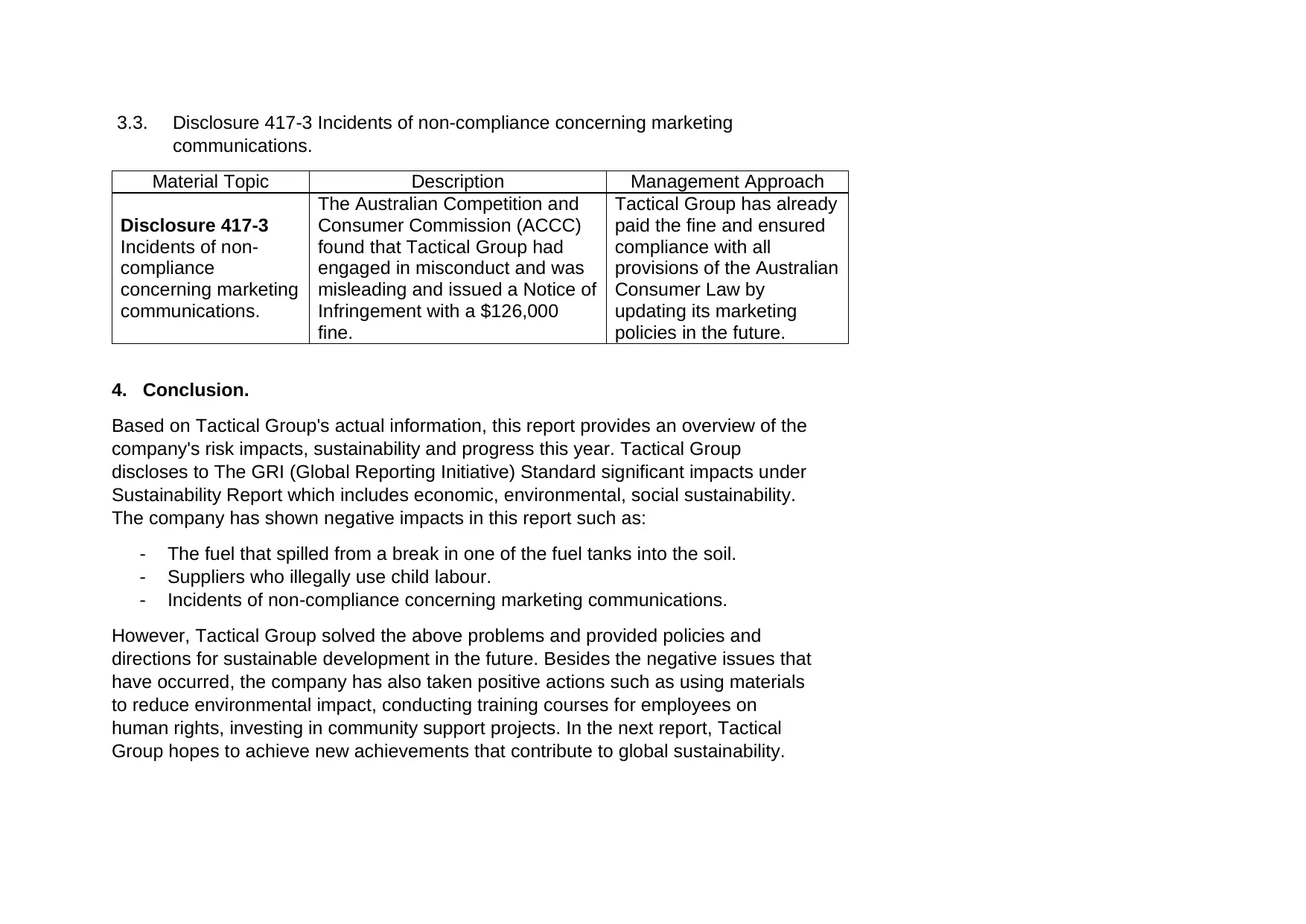
3.3. Disclosure 417-3 Incidents of non-compliance concerning marketing
communications.
Material Topic Description Management Approach
Disclosure 417-3
Incidents of non-
compliance
concerning marketing
communications.
The Australian Competition and
Consumer Commission (ACCC)
found that Tactical Group had
engaged in misconduct and was
misleading and issued a Notice of
Infringement with a $126,000
fine.
Tactical Group has already
paid the fine and ensured
compliance with all
provisions of the Australian
Consumer Law by
updating its marketing
policies in the future.
4. Conclusion.
Based on Tactical Group's actual information, this report provides an overview of the
company's risk impacts, sustainability and progress this year. Tactical Group
discloses to The GRI (Global Reporting Initiative) Standard significant impacts under
Sustainability Report which includes economic, environmental, social sustainability.
The company has shown negative impacts in this report such as:
- The fuel that spilled from a break in one of the fuel tanks into the soil.
- Suppliers who illegally use child labour.
- Incidents of non-compliance concerning marketing communications.
However, Tactical Group solved the above problems and provided policies and
directions for sustainable development in the future. Besides the negative issues that
have occurred, the company has also taken positive actions such as using materials
to reduce environmental impact, conducting training courses for employees on
human rights, investing in community support projects. In the next report, Tactical
Group hopes to achieve new achievements that contribute to global sustainability.
communications.
Material Topic Description Management Approach
Disclosure 417-3
Incidents of non-
compliance
concerning marketing
communications.
The Australian Competition and
Consumer Commission (ACCC)
found that Tactical Group had
engaged in misconduct and was
misleading and issued a Notice of
Infringement with a $126,000
fine.
Tactical Group has already
paid the fine and ensured
compliance with all
provisions of the Australian
Consumer Law by
updating its marketing
policies in the future.
4. Conclusion.
Based on Tactical Group's actual information, this report provides an overview of the
company's risk impacts, sustainability and progress this year. Tactical Group
discloses to The GRI (Global Reporting Initiative) Standard significant impacts under
Sustainability Report which includes economic, environmental, social sustainability.
The company has shown negative impacts in this report such as:
- The fuel that spilled from a break in one of the fuel tanks into the soil.
- Suppliers who illegally use child labour.
- Incidents of non-compliance concerning marketing communications.
However, Tactical Group solved the above problems and provided policies and
directions for sustainable development in the future. Besides the negative issues that
have occurred, the company has also taken positive actions such as using materials
to reduce environmental impact, conducting training courses for employees on
human rights, investing in community support projects. In the next report, Tactical
Group hopes to achieve new achievements that contribute to global sustainability.
Paraphrase This Document
Need a fresh take? Get an instant paraphrase of this document with our AI Paraphraser
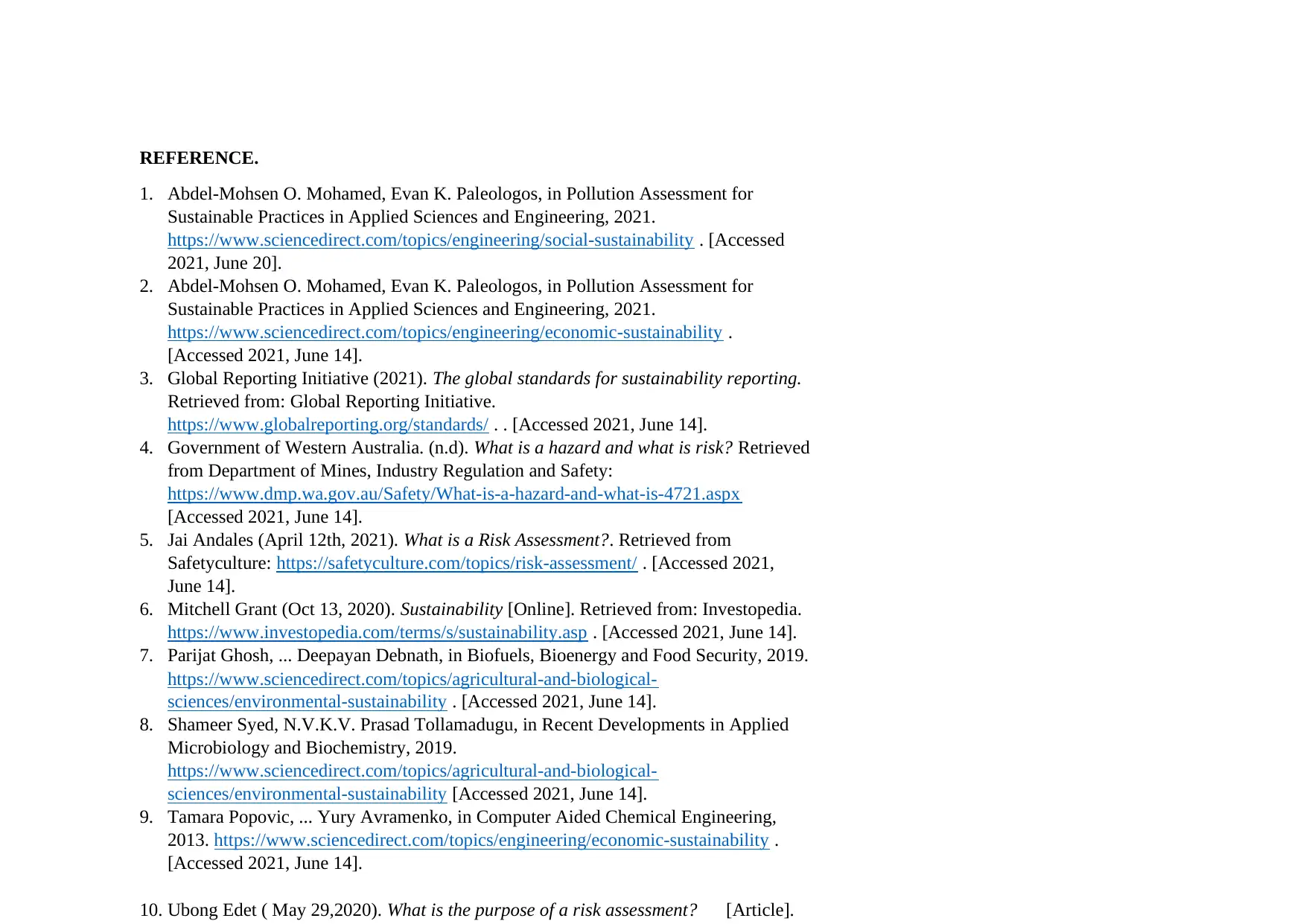
REFERENCE.
1. Abdel-Mohsen O. Mohamed, Evan K. Paleologos, in Pollution Assessment for
Sustainable Practices in Applied Sciences and Engineering, 2021.
https://www.sciencedirect.com/topics/engineering/social-sustainability . [Accessed
2021, June 20].
2. Abdel-Mohsen O. Mohamed, Evan K. Paleologos, in Pollution Assessment for
Sustainable Practices in Applied Sciences and Engineering, 2021.
https://www.sciencedirect.com/topics/engineering/economic-sustainability .
[Accessed 2021, June 14].
3. Global Reporting Initiative (2021). The global standards for sustainability reporting.
Retrieved from: Global Reporting Initiative.
https://www.globalreporting.org/standards/ . . [Accessed 2021, June 14].
4. Government of Western Australia. (n.d). What is a hazard and what is risk? Retrieved
from Department of Mines, Industry Regulation and Safety:
https://www.dmp.wa.gov.au/Safety/What-is-a-hazard-and-what-is-4721.aspx
[Accessed 2021, June 14].
5. Jai Andales (April 12th, 2021). What is a Risk Assessment?. Retrieved from
Safetyculture: https://safetyculture.com/topics/risk-assessment/ . [Accessed 2021,
June 14].
6. Mitchell Grant (Oct 13, 2020). Sustainability [Online]. Retrieved from: Investopedia.
https://www.investopedia.com/terms/s/sustainability.asp . [Accessed 2021, June 14].
7. Parijat Ghosh, ... Deepayan Debnath, in Biofuels, Bioenergy and Food Security, 2019.
https://www.sciencedirect.com/topics/agricultural-and-biological-
sciences/environmental-sustainability . [Accessed 2021, June 14].
8. Shameer Syed, N.V.K.V. Prasad Tollamadugu, in Recent Developments in Applied
Microbiology and Biochemistry, 2019.
https://www.sciencedirect.com/topics/agricultural-and-biological-
sciences/environmental-sustainability [Accessed 2021, June 14].
9. Tamara Popovic, ... Yury Avramenko, in Computer Aided Chemical Engineering,
2013. https://www.sciencedirect.com/topics/engineering/economic-sustainability .
[Accessed 2021, June 14].
10. Ubong Edet ( May 29,2020). What is the purpose of a risk assessment? [Article].
1. Abdel-Mohsen O. Mohamed, Evan K. Paleologos, in Pollution Assessment for
Sustainable Practices in Applied Sciences and Engineering, 2021.
https://www.sciencedirect.com/topics/engineering/social-sustainability . [Accessed
2021, June 20].
2. Abdel-Mohsen O. Mohamed, Evan K. Paleologos, in Pollution Assessment for
Sustainable Practices in Applied Sciences and Engineering, 2021.
https://www.sciencedirect.com/topics/engineering/economic-sustainability .
[Accessed 2021, June 14].
3. Global Reporting Initiative (2021). The global standards for sustainability reporting.
Retrieved from: Global Reporting Initiative.
https://www.globalreporting.org/standards/ . . [Accessed 2021, June 14].
4. Government of Western Australia. (n.d). What is a hazard and what is risk? Retrieved
from Department of Mines, Industry Regulation and Safety:
https://www.dmp.wa.gov.au/Safety/What-is-a-hazard-and-what-is-4721.aspx
[Accessed 2021, June 14].
5. Jai Andales (April 12th, 2021). What is a Risk Assessment?. Retrieved from
Safetyculture: https://safetyculture.com/topics/risk-assessment/ . [Accessed 2021,
June 14].
6. Mitchell Grant (Oct 13, 2020). Sustainability [Online]. Retrieved from: Investopedia.
https://www.investopedia.com/terms/s/sustainability.asp . [Accessed 2021, June 14].
7. Parijat Ghosh, ... Deepayan Debnath, in Biofuels, Bioenergy and Food Security, 2019.
https://www.sciencedirect.com/topics/agricultural-and-biological-
sciences/environmental-sustainability . [Accessed 2021, June 14].
8. Shameer Syed, N.V.K.V. Prasad Tollamadugu, in Recent Developments in Applied
Microbiology and Biochemistry, 2019.
https://www.sciencedirect.com/topics/agricultural-and-biological-
sciences/environmental-sustainability [Accessed 2021, June 14].
9. Tamara Popovic, ... Yury Avramenko, in Computer Aided Chemical Engineering,
2013. https://www.sciencedirect.com/topics/engineering/economic-sustainability .
[Accessed 2021, June 14].
10. Ubong Edet ( May 29,2020). What is the purpose of a risk assessment? [Article].
1 out of 8
Related Documents
Your All-in-One AI-Powered Toolkit for Academic Success.
+13062052269
info@desklib.com
Available 24*7 on WhatsApp / Email
![[object Object]](/_next/static/media/star-bottom.7253800d.svg)
Unlock your academic potential
Copyright © 2020–2025 A2Z Services. All Rights Reserved. Developed and managed by ZUCOL.





